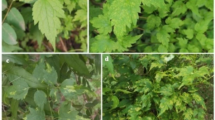Abstract
The ti plant (Cordyline fruticosa L.) is culturally important throughout most of Polynesia and has considerable economic importance in Hawai’i where the foliage is commonly used in cultural ceremonies as well as food and ornamental industries. In Hawai’i, ringspot symptoms were recently observed on leaves of the common green variety of ti growing in Kahalu’u on the island of O’ahu, and Wailuku and Hana on the island of Maui. High molecular weight double-stranded (ds)RNAs were isolated from the leaves of symptomatic plants as well as plants without symptoms. A cDNA library derived from the dsRNAs present in symptomatic plants was generated and sequenced. These sequences indicated at least four distinct clostero-like viruses were present in the plants, and phylogenetic analyses suggested they were most closely related to Little cherry virus 1, an unassigned member of the family Closteroviridae. The 16,883 nucleotide genome of one of these viruses was determined and predicted to contain ten open reading frames with an organization typical of closteroviruses. Reverse-transcription PCR revealed this virus was present in both symptomatic and asymptomatic ti plants, making it unlikely to be responsible for the observed ringspot symptoms. We propose the name Cordyline virus 1 (CoV-1) for this virus and include it as a new, unassigned member of the family Closteroviridae.





Similar content being viewed by others
Abbreviations
- AFLP:
-
Amplified fragment length polymorphism
- cDNA:
-
Complementary DNA
- dNTP:
-
Deoxyribonucleotide triphosphate
- DTT:
-
Dithiothreitol
- KCl:
-
Potassium chloride
- MgCl2 :
-
Magnesium chloride
- PCR:
-
Polymerase chain reaction
- RLM-RACE:
-
RNA ligase-mediated rapid amplification of cDNA ends
References
A.V. Karasev, Annu. Rev. Phytopathol. 38, 293–324 (2000)
G.P. Martelli, A.A. Agranovsky, M. Bar-Joseph, D. Boscia, T. Candresse, R.H.A. Couts, V.V. Dolja, B.W. Falk, D. Gonsalves, W. Jelkmann, A.V. Karasev, A. Minafra, S. Namba, H.J. Vetten, G.C. Wisler, N. Yoshikawa, Arch. Virol. 147, 2039–2044 (2002)
W. Jelkmann, B. Fechtner, A.A. Agranovsky, J. Gen. Virol. 78, 2067–2071 (1997)
D.M. Sether, M.J. Melzer, J. Busto, F. Zee, J.S. Hu, Plant Dis. 89, 450–456 (2005)
S.W. Prosser, D.E. Goszcynski, B. Meng, Virus Res. 124, 151–159 (2007)
A.E. Hinkle, Am. J. Bot. 94, 828–839 (2007)
E.S.C. Handy, E.G. Handy, Native Planters in Old Hawaii (Bishop Museum Press, Honolulu, 1972), pp. 222–225
M.E. Hudson, K.J. Whetstone, in Statistics of Hawaii Agriculture 2008 (USDA, NASS, Hawaii Field Office, 2010), http://www.nass.usda.gov/Statistics_by_State/Hawaii/Publications/Annual_Statistical_Bulletin/stat-26.pdf. Accessed 23 June 2010
T.J. Morris, J.A. Dodds, Phytopathology 69, 854–858 (1979)
J.S. Hu, A. Gonsalves, D. Sether, D.E. Ullman, Acta Hortic. 334, 411–416 (1993)
M.J. Melzer, W.B. Borth, D.M. Sether, S. Ferreira, D. Gonsalves, J.S. Hu, Virus Genes 40, 111–118 (2010)
X. Huang, A. Madan, Genome Res. 9, 868 (1999)
R.H.A. Coutts, I.C. Livieratos, J. Phytopathol. 151, 525–527 (2003)
J.D. Thompson, T.J. Gibson, F. Plewniak, F. Jeanmougin, D.G. Higgins, Nucleic Acids Res. 24, 4876 (1997)
J. Felsenstein, Cladistics 5, 164–166 (1989)
J.P. Huelsenbeck, F. Ronquist, Bioinformatics 17, 754 (2001)
F. Ronquist, J.P. Huelsenbeck, Bioinformatics 19, 1572 (2003)
R.D.M. Page, Comput. Appl. Biosci. 12, 357–358 (1996)
S.F. Altschul, W. Gish, W. Miller, E.W. Myers, D.J. Lipman, J. Mol. Biol. 215, 403–410 (1990)
S.F. Altschul, M.S. Boguski, W. Gish, J.C. Wootton, Nat. Genet. 6, 119–129 (1994)
M.N. Rozanov, E.V. Koonin, A.E. Gorbalenya, J. Gen. Virol. 73, 2129–2134 (1992)
A.E. Gorbalenya, E.V. Koonin, Curr. Opin. Struct. Biol. 3, 419–429 (1993)
M.S. Bratlie, F. Drabløs, BMC Genomics 6 (2005). doi:10.1186/1471-2164-6-1
E.V. Koonin, J. Gen.Virol. 72, 2197–2206 (1991)
J. Ting, A.S. Lee, DNA 7, 275–286 (1988)
I.C. Livieratos, E. Eliasco, G. Müller, R.C.L. Olsthoorn, L.F. Salazar, C.W.A. Pleij, R.H.A. Coutts, J. Gen. Virol. 85, 2065–2075 (2004)
N.M. Salem, A.Y.S. Chen, I.E. Tzanetakis, C. Mongkolsiriwattana, J.C.K. Ng, Virology 390, 45–55 (2009)
G. Martin, L. Velasco, E. Segundo, I.M. Cuadrado, D. Janssen, Arch. Virol. 153, 999–1001 (2008)
V.V. Dolja, V.P. Boyko, A.A. Agranovsky, E.V. Koonin, Virology 184, 79–86 (1991)
M.E. Rott, W. Jelkmann, Arch. Virol. 150, 107–123 (2005)
K. Kobayashi, J. Griffis, A. Kawabata, G. Sako, Hawaiian Ti (University of Hawai’i, 2007), http://www.ctahr.hawaii.edu/oc/freepubs/pdf/OF-33.pdf. Accessed 23 June 2010
G. Nyland, A.C. Goheen, Annu. Rev. Phytopathol. 7, 331–354 (1969)
Q.C. Wang, B. Panis, F. Engelmann, M. Lambardi, J.P.T. Valkonen, Ann. Appl. Biol. 154, 351–363 (2009)
Q. Wang, W.J. Cuellar, M.L. Rajamäki, Y. Hirata, J.P.T. Valkonen, Mol. Plant Pathol. 9, 237–250 (2008)
D.M. Sether, C. Okumura, M.M. Kislan, J.L. Busto, C. Arakawa, F. Zee, A.V. Karasev, J.S. Hu, Plant Dis. 85, 856–864 (2001)
Author information
Authors and Affiliations
Corresponding author
Electronic supplementary material
Below is the link to the electronic supplementary material.
11262_2010_537_MOESM1_ESM.tif
Fig. S1 Phylogenetic placement of CoV-1 within the family Closteroviridae. The phylogram is based on the HEL, RdRp, HSP70h, and CP sequences linked together using a Bayesian analysis. Similar results were obtained using neighbor-joining and parsimony analyses. Viral abbreviations are given in Table 1. The scale represents the distance for the indicated number of substitutions. Branch numbers are posterior probabilities and an indication of branch support. Branches with a posterior probability value of less than 70 were collapsed. (TIFF 160 kb)
Rights and permissions
About this article
Cite this article
Melzer, M.J., Sether, D.M., Borth, W.B. et al. An assemblage of closteroviruses infects Hawaiian ti (Cordyline fruticosa L.). Virus Genes 42, 254–260 (2011). https://doi.org/10.1007/s11262-010-0537-9
Received:
Accepted:
Published:
Issue Date:
DOI: https://doi.org/10.1007/s11262-010-0537-9




